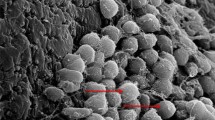Abstract
To study the microbiological profile in patients with chronic rhino-sinusitis. To correlate disease severity with the presence of biofilms and host risk factors. To assess outcome of Sinus Surgery 2 weeks post operatively in terms of presence of bacteria and their ability to form biofilm. Prospective study. 50 cases of chronic rhino-sinusitis requiring Functional Endoscopic Sinus Surgery admitted in SDM Hospital, Dharwad, Karnataka were studied using intra-operative mucosal samples for microbiological analysis. The organisms isolated were tested for biofilm forming ability using three in vitro tests. Severity of disease was assessed using SNOT 22 scoring system. Of 50 cases studied, 66% showed presence of chronic rhino-sinusitis with polyposis and had higher SNOT scores compared to those without polyps. Bacterial isolates were obtained from only 17 samples. Staphylococcus species was isolated from 16 samples and Klebsiella pneumoniae from one. 11 Staph spp. isolates showed biofilm forming ability in vitro. Postoperative events in 3 cases yielded biofilm-forming Staphylococcus. Staphylococcus was the most dominant organism isolated and 11 isolates were biofilm formers. Thus the detection of biofilm forming organisms can be considered as a negative prognostic indicator and should forewarn the surgeon about the risk of recurrence.


Similar content being viewed by others
References
Fokkens WJ, Lund VJ, Mullol J et al (2012) The European position paper on rhinosinusitis and nasal polyps 2012. Rhinol Suppl 23:1–299
Kennedy DW, Ramakrishnan VR (2015) Functional endoscopic sinus surgery: concepts, surgical indications and techniques. In: Kennedy DW, Hwang PH (eds) Rhinology diseases of the nose, sinuses, and skull base, 1st edn. Thieme, New York, pp 308–335
Hopkins C, Gillett S, Slack R et al (2009) Psychometric validity of the 22-item sinonasal outcome test. Clin Otolaryngol 34:447–454
Gonz′alez-Castro J, Pascual J, Busquets J (2013) National survey on the use of preoperative systemic steroids in endoscopic sinus surgery. Int Forum Allergy Rhinol 3(6):497–503
Bauer AW, Kirby WMM, Sherris JC et al (1966) Antibiotic susceptibility testing by standardized single disc method. Am J Clin Pathol 45:493–496
Christensen GD, Bisno AL, Simpsom WA, Beachey EH (1982) Adherence of slime producing strains of Staphylococcus epidermidis to smooth surfaces. Infect Immun 7:318–326
Freeman DJ, Falkiner FR, Keane CT (1989) New method for detecting slime production by coagulase negative staphylococci. J ClinPathol 42:872–874
Mathur T, Singhal S, Khan S et al (2006) Detection of biofilm formation among isolates of staphylococci: an evaluation of three different screening methods. Indian J Med Microbiol 24(1):25–29
Senior BA, Kennedy DW, Tanabodee J et al (1998) Long-term results of functional endoscopic sinus surgery. Laryngoscope 108:151–157
Sanclement JA, Webster P, Thomas J, Ramadan HH (2005) Bacterial biofilms in surgical specimens of patients with chronic rhinosinusitis. Laryngoscope 115:578–582
Psaltis AJ, Weitzel EK, Ha KR, Wormald PJ (2008) The effect of bacterial biofilms on post-sinus surgical outcomes. Am J Rhinol 22:1–6
Krouse JH (2005) Allergy and chronic rhinosinusitis. Otolaryngol Clin North Am 38:1257–1266 (ix–x)
Prince AA, Steiger JD, Khalid AN et al (2008) Prevalence of biofilm-forming bacteria in chronic rhinosinusitis. Am J Rhinol 22:239–245
Perloff JR, Palmer JN (2004) Evidence of bacterial biofilms on frontal recess stents in patients with chronic rhinosinusitis. Am J Rhinol 18(6):377–380
Niederfuhr A, Kirsche H, Riechelmann H, Wellinghausen N (2009) The bacteriology of chronic rhinosinusitis with and without nasal polyps. Arch Otolaryngol Head Neck Surg 135:131–136
Conley DB, Tripathi A, Seiberling KA et al (2006) Superantigens and chronic rhinosinusitis II: analysis of T-cell receptor V beta domains in nasal polyps. Am J Rhinol 20(4):451–455
Bhattacharyya N, Kepnes LJ (2008) Assessment of trends in antimicrobial resistance in chronic rhinosinusitis. Ann Otol Rhinol Laryngol 117:448–452
Oliveira A, Cunha MLRS (2010) Comparison of methods for the detection of biofilm production in coagulase-negative staphylococci. BMC Res Notes 3:260
Author information
Authors and Affiliations
Corresponding author
Ethics declarations
Conflict of interest
Authors declare that they have no conflict of interest. No external funding was used for the study.
Ethical Approval
This article does not contain any studies with animals performed by any of the authors.
Informed Consent
Informed consent was obtained from all individual participants included in the study.
Rights and permissions
About this article
Cite this article
Karunasagar, A., Garag, S.S., Appannavar, S.B. et al. Bacterial Biofilms in Chronic Rhinosinusitis and Their Implications for Clinical Management. Indian J Otolaryngol Head Neck Surg 70, 43–48 (2018). https://doi.org/10.1007/s12070-017-1208-0
Received:
Accepted:
Published:
Issue Date:
DOI: https://doi.org/10.1007/s12070-017-1208-0




